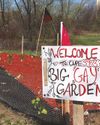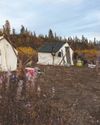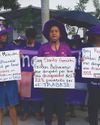Remembering The Drumheller Strike
Briarpatch
|May/June 2018
“Hell’s Hole,” “the Devil’s Row,” and “the Western Front” – these were the nicknames for the coal mines of the Drumheller valley. In 1919, around 6,500 Drumheller coal miners walked off the job after voting to join the radical and militant One Big Union. Nearly a hundred years later, the 1919 Drumheller strike remains one of the most famous examples of workers’ power on the Prairies.

Robert MacDonald was walking down a street in Drumheller, Alberta, on a summer Saturday evening in 1919 when he saw a group of men walking toward him. One of the men pointed at him and said to the others, “Here’s another One Big Union guy. Take him away.”
The men hustled MacDonald into a car and drove him to a barn outside of town where other local coal miners were also being dropped off. One man showed MacDonald his loaded shotgun. Another, pointing at a beam on the roof, told the captured coal miners, “We’re going to hang you on that beam.”
MacDonald was one of thousands of Drumheller coal miners who, two months earlier, had voted to join the radical and militant One Big Union (OBU) and strike for union recognition. The men who had grabbed him off the street were working for the bosses, and threatened to kill him for no other reason than that he was a worker on strike who had dared to walk down the street alone.
DRUMHELLER’S DISGRACE
The swath of southern Alberta which included the Drumheller Valley was originally the home of mostly Niitsitapi, Assiniboine, and Tsuut’ina peoples, and became Treaty 7 territory in 1877. Mine owners in the Drumheller valley who began buying up parcels of coal-rich land in the early 20th century wanted to make money as quickly as possible. Bosses lured new immigrants from Europe to work in the valley with promises of company housing and good wages.
Diese Geschichte stammt aus der May/June 2018-Ausgabe von Briarpatch.
Abonnieren Sie Magzter GOLD, um auf Tausende kuratierter Premium-Geschichten und über 9.000 Zeitschriften und Zeitungen zuzugreifen.
Sie sind bereits Abonnent? Anmelden
WEITERE GESCHICHTEN VON Briarpatch

Briarpatch
PLATFORMS FOR PEOPLE, NOT PROFIT
Digital platforms boast that they’ve “democratized” cultural production. But what would truly democratic platforms look like in Canada?
10 mins
January/February 2020

Briarpatch
ORGANIZING THROUGH LOSS IN THE HEART OF OIL COUNTRY
The story of climate justice organizing in Alberta, at the heart of the tarsands, is the story of a group of young activists learning what it means to lose, and keep on fighting
13 mins
January/February 2020

Briarpatch
GROWING THE LABOUR MOVEMENT
How unions are using community gardens to engage members, nourish communities, and help strikers weather the picket line
11 mins
January/February 2020

Briarpatch
A NEW ERA FOR OLD CROW
In the Yukon’s northernmost community, the Vuntut Gwitchin First Nation is reckoning with how to preserve their land and culture, amid a warming climate and an influx of tourists
16 mins
January/February 2020

Briarpatch
“At Least Hookers Get Wages”
The risky business of sex work in the gig economy
14 mins
November/December 2019

Briarpatch
The Literal – And Literary – Futures We Build
Briarpatch editor Saima Desai talks to two judges of our Writing in the Margins contest about Idle No More and MMIWG, ethical kinship, writing queer sex, and their forthcoming work.
9 mins
November/December 2019

Briarpatch
The Cost Of A T-Shirt
In Honduras, women maquila workers are fighting back against the multinational garment companies that they say are endangering their health and safety.
18 mins
November/December 2019

Briarpatch
Milking Prison Labour
Canada’s prison farms are being reopened. But when prisoners will be paid pennies a day, and the fruits of their labour will likely be exported for profit, there’s little to celebrate.
12 mins
November/December 2019

Briarpatch
Bringing Back The Beat
In mainstream media, labour journalism has been replaced by financial reporting and business sections. But journalism students are raising the labour beat from the grave.
10 mins
November/December 2019

Briarpatch
There's No Journalism On A Dead Planet
Corporate media owners are killing local newspapers – which is making it impossible for everyday people to understand the on-the-ground impacts of the climate crisis
18 mins
September/October 2019
Translate
Change font size

